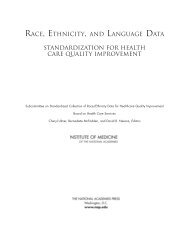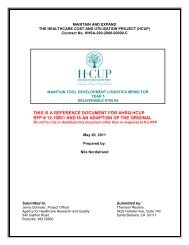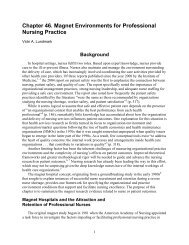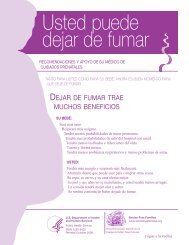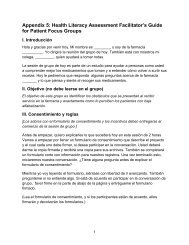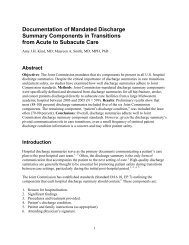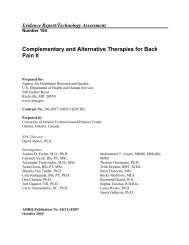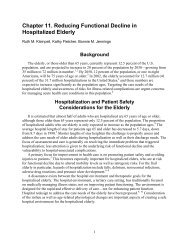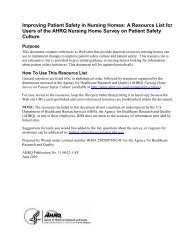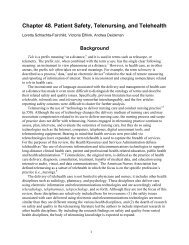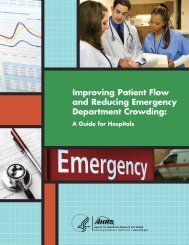Emergency Severity Index (ESI): A Triage Tool for Emergency ...
Emergency Severity Index (ESI): A Triage Tool for Emergency ...
Emergency Severity Index (ESI): A Triage Tool for Emergency ...
You also want an ePaper? Increase the reach of your titles
YUMPU automatically turns print PDFs into web optimized ePapers that Google loves.
headache treatment. <strong>ESI</strong> level-3 patients triaged to<br />
UC and all patients sent to the acute area from UC<br />
<strong>for</strong> more serious conditions are monitored in the<br />
quality improvement program. Nurses using the <strong>ESI</strong><br />
have reported that the tool facilitates<br />
communication of patient acuity more effectively<br />
than the <strong>for</strong>mer three-level triage scales used at the<br />
sites (Wuerz et al., 2001). For example, the triage<br />
nurse can tell the charge nurse, "I need a bed <strong>for</strong> a<br />
level-2 patient," and through this common<br />
language, the charge nurse understands what is<br />
needed without a detailed explanation of the<br />
patient by the triage nurse. Hospital administrators<br />
can use the case mix in real time to help make<br />
decisions regarding the need <strong>for</strong> additional resources<br />
or possibly diverting ambulance arrivals. If a waiting<br />
room has multiple level-2 patients with long waits,<br />
the hospital may need to develop a plan <strong>for</strong> the<br />
disposition of those patients who are waiting <strong>for</strong> an<br />
inpatient bed and occupying space in the ED.<br />
The <strong>ESI</strong> also has been used as the foundation <strong>for</strong> ED<br />
policies that address specific populations. For<br />
example, the psychiatric service at one site is<br />
expected to provide consults <strong>for</strong> level-2 and level-3<br />
patients with psychiatric complaints within 30<br />
minutes of notification and <strong>for</strong> level-4 and level-5<br />
patients within 1 hour. At another site, the <strong>ESI</strong> has<br />
been incorporated into a policy <strong>for</strong> patients greater<br />
than 20 weeks pregnant who present to the ED.<br />
Patients rated at <strong>ESI</strong> levels 1 and 2 are treated in the<br />
ED by emergency medicine with an obstetrical<br />
consult. Those rated 3, 4, or 5 are triaged to the<br />
labor and delivery area of the hospital.<br />
Standardization of ED triage acuity data using the<br />
<strong>ESI</strong> is beneficial <strong>for</strong> secondary uses of ED data. For<br />
example, ED crowding researchers have<br />
incorporated the <strong>ESI</strong> into metrics <strong>for</strong> measuring and<br />
predicting ED crowding (Bernstein, Verghese, Leung,<br />
Lunney, Perez, 2003). Wider adoption of the <strong>ESI</strong> by<br />
U.S. hospitals could lead to the establishment of a<br />
true standard <strong>for</strong> triage acuity assessment, which<br />
will facilitate benchmarking, public health<br />
surveillance, and research.<br />
References<br />
American College of <strong>Emergency</strong> Physicians (2010). ACEP<br />
policy statements: <strong>Triage</strong> scale standardization. Dallas,<br />
TX: American College of <strong>Emergency</strong> Physicians.<br />
Retrieved June 1, 2011, from http://www.acep.org/<br />
Content.aspx?id=29828&terms=triage%scale.<br />
Chapter 1. Introduction to the <strong>Emergency</strong> <strong>Severity</strong> <strong>Index</strong>: A Research-Based <strong>Triage</strong> <strong>Tool</strong><br />
5<br />
Barthell EN, Coonan K, Finnell J, Pollock D, Cochrane D<br />
(2004). Disparate systems, disparate data: integration,<br />
interfaces and standards in emergency medicine<br />
in<strong>for</strong>mation technology. Acad Emerg Med. 11(11):1142-<br />
1148.<br />
Baumann MR, Strout TD (2007). <strong>Triage</strong> of geriatric<br />
patients in the emergency department: validity and<br />
survival with the <strong>Emergency</strong> <strong>Severity</strong> <strong>Index</strong>. Ann Emerg<br />
Med. 49:234-240.<br />
Bernstein SL, Verghese V, Leung W, Lunney AT, Perez I<br />
(2003). Development and validation of a new index to<br />
measure emergency department crowding. Acad Emerg<br />
Med. 10(9):938-942.<br />
Centers <strong>for</strong> Disease Control and Prevention (2008).<br />
National Hospital Ambulatory Medical Care Survey: 2008<br />
<strong>Emergency</strong> department summary tables. Retrieved June<br />
6, 2011 from http://www.cdc.gov/nchs/data/ahcd/<br />
nhamcs_emergency/nhamcsed2008.pdf.<br />
Chi CJ, Huang CM (2006). Comparison of the <strong>Emergency</strong><br />
<strong>Severity</strong> <strong>Index</strong> (<strong>ESI</strong>) and the Taiwan <strong>Triage</strong> System in<br />
predicting resource utilization. J Formos Med Assoc.<br />
105(8):617-625.<br />
Durani Y, Breecher D, Walmsley D, Attia MW, Loiselle JM<br />
(2009). The <strong>Emergency</strong> <strong>Severity</strong> <strong>Index</strong> version 4<br />
reliability in pediatric patients. Pediatr Emerg Care.<br />
25(8):504-507.<br />
Eitel DR, Travers DA, Rosenau A, Gilboy N, Wuerz RC<br />
(2003). The <strong>Emergency</strong> <strong>Severity</strong> <strong>Index</strong> version 2 is<br />
reliable and valid. Acad Emerg Med. 10(10):1079-1080.<br />
Elshove-Bolk J, Mencl F, van Rijswijck BTF, Simons MP,<br />
van Vugt AB (2007). Validation of the <strong>Emergency</strong><br />
<strong>Severity</strong> <strong>Index</strong> (<strong>ESI</strong>) in self-referred patients in a<br />
European emergency department. Emerg Med. 24:170-<br />
174.<br />
<strong>Emergency</strong> Nurses Association (2003). Position statements:<br />
ENA board approves statement on joint ENA/ACEP<br />
five-level triage task <strong>for</strong>ce. Des Plaines, IL. Retrieved<br />
February 10, 2005, from www.ena.org/about/position.<br />
Fernandes C, Tanabe P, Gilboy N, Johnson L, McNair R,<br />
Rosenau A, Sawchuk P, Thompson DA, Travers DA,<br />
Bonalumi N, Suter RE (2005). Five level triage: A report<br />
from the ACEP/ENA Five Level <strong>Triage</strong> Task Force. JEN.<br />
31(1):39-50.<br />
Friedman Singer R, Infante AA, Oppenheimer CC, West<br />
CA, Siegel B (in press). The use of and satisfaction with<br />
the <strong>Emergency</strong> <strong>Severity</strong> <strong>Index</strong>. JEN.<br />
Gilboy N, Travers DA, Wuerz RC (1999). Re evaluating<br />
triage in the new millennium: A comprehensive look at<br />
the need <strong>for</strong> standardization and quality. JEN.<br />
25(6):468 -473.



